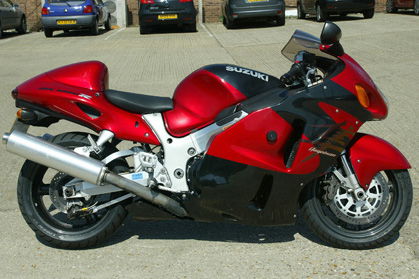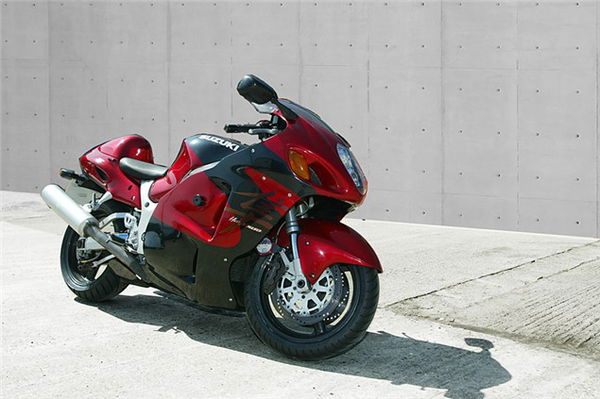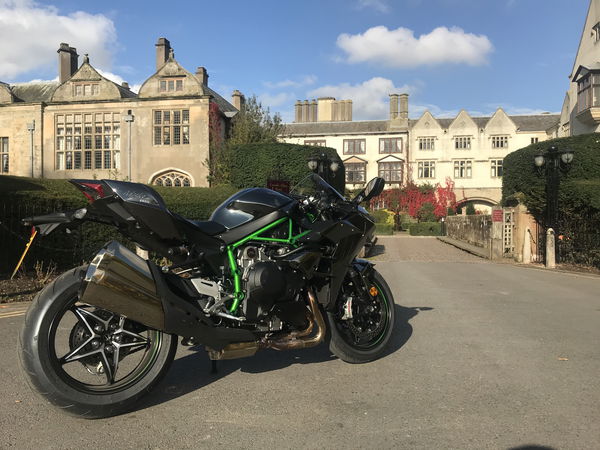Used Test: Suzuki GSX1300R Hayabusa
Half elephant, half cyclops, but all-conquering when it came to the title of King of Speed in the late 1990s, the Hayabusa is still the yardstick for sheer velocity and a fantastic cult motorcycle.

 |
The figures take some beating: 192mph, 157bhp, a quarter-mile in just 10 seconds and you could have all this for just a shade over £3,000. Suzuki's Hayabusa came on the scene in 1999 and the lumpy looks were for a reason: this bike was one of the first to be designed with a lot of wind-tunnel time with a rider on top. Over the years the 'Busa has proved to be a pretty reliable tool with no major vices. Sure, you need to keep on top of the thing finish-wise and cast a wet rag over it now and again - but that's no different from any Suzukis of a similar age. Despite hanging on way too long in the range, the Hayabusa is now due to be replaced by the end of the year by the new breed of Hayabusa - a next-generation 1,340cc monster with updated everything and the ugliest bodywork ever made.
ENGINE
Still impressive. The 1,299cc fuel-injected, liquid-cooled motor produces 157bhp at the rear tyre. Torque is available from any revs - 3,000rpm and up. If you're brave enough, then hang on to the 11,000rpm redline. Extremely reliable, can do clutches if too many standing-starts have been through the motor. Incredibly tuneable - 200bhp is very easy indeed. If you need it.
REAR SUSPENSION
Could be knackered by now, especially on early examples. The stock unit can be re-valved for a couple of hundred notes, but many owners go for an aftermarket replacement. As an example, Nitron do three levels of upgraded shock: the NTR Sport for around £300 with a single adjuster for compression and rebound, the NTR Track with independent adjusters for £455 and the NTR Race for £475 which also incorporates high and low-speed compression damping for the ultimate in fine-tuning.
HANDLING
Not too bad for a machine of this class. The bike was launched at Catalunya in Spain and it impressed. Modern litre-class sportsbikes and the ZZR1400 are now in a different league, but more to the point the oldest 'Busas will now be best part of a decade old - so check forks for pitting, leaky fork seals and general soft-ness all round.
GEARBOX
Some owners have reported cases where the bike feels like the chain is hopping off the rear sprocket in certain gears. The widest reported is between 2nd and 3rd gears with others having the problem between 3rd and 4th. Sometimes this problem will lead to the dogs wearing out, bending the shift fork and sometimes wearing a groove in the shift drum. Some work has been carried out by Suzuki under warranty, but other owners have had to carry the can, undercutting the gears in the process to help things considerably.
BUILD QUALITY/FINISH
Typical of a Suzuki of this vintage: patchy. If you look after it, it'll look after you. If you don't they can rot - and fast. Particularly bad can be wheel paint, stickers and bodywork, as well as nuts and bolts and shocks.
FUEL-INJECTION
Compared to other early Japanese fuel-injection offerings, such as the CBR929R FireBlade, the Hayabusa's 'carburation' was spot-on. At launch journos were tonking around Catalunya in top gear and that included the 30mph hairpins. It's that flexible... The only blip is at 5,000rpm in third gear (emissions) On early models, whipping out the pink wire in the ECU would sort this out.
TRE/DE-RESTRICTING
A Timing Retard Eliminator is a popular mod. Some people say post 2003 models (with later ECUs) don't work with them, but the majority say they do. The speed limiter is an electronic one that retards the injector of spark to one of the cylinders once the various engine sensors reach a certain speed limit. It does not restrict engine power until then. As the ignition is retarded in 1st, 2nd and 6th the TRE tells the ECU that you're in 5th and therefore gives you 'full-bore' It's handy to do this mod in conjunction with a Power Commander and some dyno time. A genuine 192mph is the result.
BRAKES
Okay for the time, but the six-pot Tokicos suffer big-time with age. Keep them as sharp as they can be with regular strip downs.
AFTERMARKET PARTS
Bigger screens are a popular mod as you can't see the analogue speedo with the normal height screen. Pipes and Power Commanders are popular with the performance brigade. Sadly, the GSX1300R also suffers from the 'GSX-R-itis' that the sportier versions do. So watch out for hideous paint-jobs and red headlight covers.
TYRES
During development a 'Busa's rear tyre could last as little as 500 miles! Thankfully things have improved considerably. Bridgestones are popular and these ( BT56R J-spec) originally came with the bike. Other J-spec tyres that are well-thought of include the Dunlop D207. Other tyres, which have proved popular are the Avon Azaro AV36. Rag the bike hard and you can shoot a rear in as little as 2,000 miles, but the normal life is around 3,000-7,000 miles.
DID THEY CHANGE AT ALL?
They're pretty much identical, but early (1999-2000) versions had speedos that had 220mph on them (cool!) while later ones had 185mph speedos. Late 2000-on models were also 'restricted' to 186mph. A different ECU was introduced in 2002-03 and the subframe changed at some point. Other than that it was pretty much as you saw it back in '99.
SECOND-HAND VALUES
GSX1300R HAYABUSA
COLOURS: Blue/silver, red/black, metallic brown/silver, gunmetal
PRICE NEW: £7,995 (1999)
£8,649 (2007)
PRICE NOW: £3,200-£8,000
COMMENTS: The Hayabusa blended monster motor and slippery aerodynamics into a epoch-marking motorcycle.
GSX1300R HAYABUSA LE
COLOURS: white/silver
PRICE NEW: £8649 (2007)
PRICE NOW: £7500-£8649
COMMENTS: Same as ever and before, but in white. For the anal among you, you may be able to pick up the Canadian LE (in black with black frame) and an American LE model in orange with a black frame.
GSX1340R HAYABUSA K8
COLOURS: Black, orange, blue
PRICE NEW: £8,999 est
COMMENTS: It comes with a new engine, which is shared with the B-King - a 1340cc monster, utilising all the know-how of the GSX-R series once more. So it's no surprise to see a three-way adjustable engine map come in, too. Bodywork is ugly, but unmistakably Hayabusa.

The figures take some beating: 192mph, 157bhp, a quarter-mile in just 10 seconds and you could have all this for just a shade over £3,000. Suzuki's Hayabusa came on the scene in 1999 and the lumpy looks were for a reason: this bike was one of the first to be designed with a lot of wind-tunnel time with a rider on top.
Over the years the 'Busa has proved to be a pretty reliable tool with no major vices. Sure, you need to keep on top of the thing finish-wise and cast a wet rag over it now and again - but that's no different from any Suzukis of a similar age. Despite hanging on way too long in the range, the Hayabusa is now due to be replaced by the end of the year by the new breed of Hayabusa - a next-generation 1,340cc monster with updated everything and the ugliest bodywork ever made.
Engine: Still impressive. The 1,299cc fuel-injected, liquid-cooled motor produces 157bhp at the rear tyre. Torque is available from any revs - 3,000rpm and up. If you're brave enough, then hang on to the 11,000rpm redline. Extremely reliable, can do clutches if too many standing-starts have been through the motor. Incredibly tuneable - 200bhp is very easy indeed. If you need it.
Rear suspension: Could be knackered by now, especially on early examples. The stock unit can be re-valved for a couple of hundred notes, but many owners go for an aftermarket replacement. As an example, Nitron do three levels of upgraded shock: the NTR Sport for around £300 with a single adjuster for compression and rebound, the NTR Track with independent adjusters for £455 and the NTR Race for £475 which also incorporates high and low-speed compression damping for the ultimate in fine-tuning.
Handling: Not too bad for a machine of this class. The bike was launched at Catalunya in Spain and it impressed. Modern litre-class sportsbikes and the ZZR1400 are now in a different league, but more to the point the oldest 'Busas will now be best part of a decade old - so check forks for pitting, leaky fork seals and general soft-ness all round.











